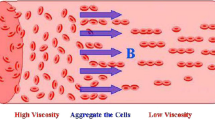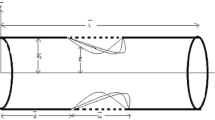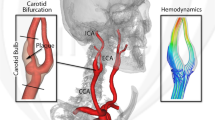Abstract
A mathematical model for blood flow through an elastic artery with multistenosis under the effect of a magnetic field in a porous medium is presented. The considered arterial segment is simulated by an anisotropically elastic cylindrical tube filled with a viscous incompressible electrically conducting fluid representing blood. An artery with mild local narrowing in its lumen forming a stenosis is analyzed. The effects of arterial wall parameters represent viscoelastic stresses along the longitudinal and circumferential directions T t and T θ , respectively. The degree of anisotropy of the vessel wall γ, total mass of the vessel, and surrounding tissues M and contributions of the viscous and elastic constraints to the total tethering C and K respectively on resistance impedance, wall shear stress distribution, and radial and axial velocities are illustrated. Also, the effects of the stenosis shape m, the constant of permeability X, the Hartmann number H α and the maximum height of the stenosis size δ on the fluid flow characteristics are investigated. The results show that the flow is appreciably influenced by surrounding connective tissues of the arterial wall motion, and the degree of anisotropy of the vessel wall plays an important role in determining the material of the artery. Further, the wall shear stress distribution increases with increasing T t and γ while decreases with increasing T θ , M, C, and K. Transmission of the wall shear stress distribution and resistance impedance at the wall surface through a tethered tube are substantially lower than those through a free tube, while the shearing stress distribution at the stenosis throat has inverse characteristic through totally tethered and free tubes. The trapping bolus increases in size toward the line center of the tube as the permeability constant X increases and decreases with the Hartmann number Ha increased. Finally, the trapping bolus appears, gradually in the case of non-symmetric stenosis, and disappears in the case of symmetric stenosis. The size of trapped bolus for the stream lines in a free isotropic tube (i.e., a tube initially unstressed) is smaller than those in a tethered tube.
Similar content being viewed by others
References
Chakravarty, S. and Chowdhury, A. G. Response of blood flow through an artery under stenotic conditions. Rheol. Acta, 27, 418–427 (1988).
Mekheimer, Kh. S., Haroun, M. H., and Elkot, M. A. Induced magnetic field influences on blood flow through an anisotropically tapered elastic arteries with overlapping stenosis in an annulus. Can. J. Phys., 89, 201–212 (2011)
Craig, I. J. D. and Watson, P. G. Magnetic reconnection solutions based on a generalized Ohm’s law. Solar Physics, 214, 131–150 (2003)
Stud, V. K., Sephon, G. S., and Mishra, R. K. Pumping action on blood flow by a magnetic field. Bull. Math. Biol., 39, 385 (1977)
Agrawal, H. L. and Anwaruddin, B. Peristaltic flow of blood in a branch. Ranchi. Univ. Math. J., 15, 111–121 (1984)
Elnaby, M. A. A. and Haroun, M. H. A new model for study the effect of wall properties on peristaltic transport of a viscous fluid. Communications in Nonlinear Science and Numerical Simulation, 13, 752–762 (2008)
Haroun, M. H. On non-linear magnetohydrodynamic flow due to Peristaltic transport of an oldroyd 3-constant fluid. Z. Naturforsch, 61a, 263–274 (2006)
Haroun, M. H. Non-linear peristaltic flow of a fourth grage fluid in an inclined asymmetric channel. Computational Material Science, 39, 324–333 (2007)
Mekheimer, Kh. S. and Elkot, M. A. The micropolar fluid model for blood flow through stenotic arteries. Int. J. Pur. Appl. Math., 4, 393–405 (2007)
Mekheimer, Kh. S. and Elkot, M. A. Influence of Magnetic field and Hall currents on blood flow through stenotic artery. Appl. Math. Mech.-Engl. Ed., 29(8), 1093–1104 (2008) DOI 10.1007/s10483-008-0813-x
Mekheimer, Kh. S. and Elkot, M. A. The micropolar fluid model for blood flow through a tapered arteries with a stenosis. Acta Mechanica Sinica, 24, 637–644 (2008)
Mekheimer, Kh. S. and Elkot, M. A. Suspension model for blood flow through arterial catheterization. Chem. Eng. Comm., 197, 1–20 (2010)
Biswas, D. and Chakraborty, U. S. Pulsatile blood flow through a catheterized artery with an axially nonsymmetrical stenosis. Applied Mathematical Sciences, 4(58), 2865–2880 (2010)
Srivastava, V. P., Rastogi, R., and Vishnoi, R. A two-layered suspension blood flow through an overlapping stenosis. Computers and Mathematics with Applications, 60, 432–441 (2010)
Sankar, D. S. and Lee, U. Two-fluid Casson model for pulsatile blood flow through stenosed arteries: a theoretical model. Communications in Nonlinear Science and Numerical Simulation, 15, 2086–2097 (2010)
Srivastava, V. P., Mishra, S., and Rastogi, R. Non-Newtonian arterial blood flow through an overlapping stenosis. Application and Applied Mathematics, 5(1), 225–238 (2010)
Siddiqui, S. U., Verma, N. K., Mishra, S., and Gupta, R. S. Mathematical modelling of pulsatile flow of Casson’s fluid in arterial stenosis. Applied Mathematics and Computation, 210, 1–10 (2009)
Layek, G. C., Mukhopadhyay, S., and Gorla, R. S. R. Unsteady viscous flow with variable viscosity in a vascular tube with an overlapping constriction. International Journal of Engineering Science, 47, 649–659 (2009)
Pincombe, B., Mazumdar, J., and Hamilton-Craig, I. Effects of multiple stenoses and post-stenotic dilatation on non-Newtonian blood flow in small arteries. Medical Biological Engineering Computing, 37, 595–599 (1999)
Tashtoush, B. and Magableh, A. Magnetic field effect on heat transfer and fluid flow characteristics of blood flow in multi-stenosis arteries. Heat Mass Transfer, 44, 297–304 (2008)
Li, M. X., Beech-Brandta, J. J., Johnb, L. R., Hoskinsc, P. R., and Eassona, W. J. Numerical analysis of pulsatile blood flow and vessel wall mechanics in different degrees of stenoses. Journal of Biomechanics, 40, 3715–3724 (2007)
Mishra, B. K. and Verma, N. Magnetic effect on blood flow in a multiple stenosed artery. Applied Mathematics and Computation, 1, 1–7 (2007)
Chakravarty, S., Datta, A., and Mandal, P. K. Analysis of nonlinear blood flow in a stenosed flexible artery. International Journal of Engineering Science, 33, 1821–1837 (1995)
Chakravarty, S. Pulsatile blood flow through arterioles. Rheol. Acta, 26, 200–207 (1987)
Atabek, H. B. and Lew, H. S. Wave propagation through a viscous incompressible fluid contained in an initially stressed elastic tube. Biophysical Journal, 6, 481–503 (1966)
Atabek, H. B. Wave propagation through a viscus fluid contained in a tethered, initially stressed, othotropic elastic tube. Biophysical Journal, 8, 626–649 (1968)
Kalita, P. and Schaefer, R. Mechanical models of artery walls. Arch. Comp. Meth. Eng., 15, 1–36 (2008)
Chakravarty, S., Sarifuddin, S., and Mandal, P. K. Unsteady flow of a two-layer blood stream past a tapered flexible artery under stenotic conditions. Comp. Meth. Appl. Math., 4, 391–409 (2004)
Author information
Authors and Affiliations
Corresponding author
Rights and permissions
About this article
Cite this article
Mekheimer, K.S., Haroun, M.H. & Elkot, M.A. Effects of magnetic field, porosity, and wall properties for anisotropically elastic multi-stenosis arteries on blood flow characteristics. Appl. Math. Mech.-Engl. Ed. 32, 1047–1064 (2011). https://doi.org/10.1007/s10483-011-1480-7
Received:
Revised:
Published:
Issue Date:
DOI: https://doi.org/10.1007/s10483-011-1480-7




